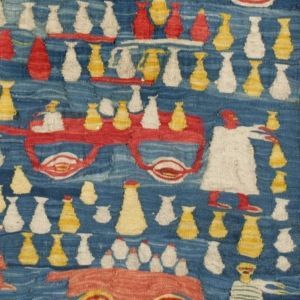Note in the Stadarchief, consulted
Exhibition Research: Let Textiles Talk
Diving into the Stadsarchiefs Amsterdam
by Amélie Martelle
by Amélie Martelle
With the information that the tapestries were acquired from the Fodor museum exhibition from 1953-1954, we turned to the Stadsarchiefs to search into the collection of saved (and digitalised) documents made available to the public. Joined by our curator-in-training, skilled Francophone and amateur translator, the reading of Sandberg’s fluently written French correspondences with Wissa Wassef was luckily unchallenged. Here are our most notable findings.
The person who initially instigated the project was a lady called Mejuffrouw E. van der Goot, living in Koog Aan de Zaan at the time. A note with her information and a letter from Wissa Wassef to Sandberg indicates she visited the centre in 1960[i]. By this first letter of Wissa Waasef, she had already offered an exhibition of the works in the Netherlands. Sandberg was contacted by Mej. Van der Goot and contacted as the same time the Stockholm Museum about the exhibition they presented. The works form the Moderna Museet was however brought back to Egypt and Wissa Wassef selected 90 different works to be sent to Amsterdam to be shown with the possibility to be sold at the Fodor Museum from the 15th of December 1961 to January 31th 1962 followed by three other exhibitions in Oslo, Bergen and Trondheim, Norway[ii].
The format of the exhibition was identified as ‘prestige’, meaning the pieces were available for purchase. Sandberg specifies however it was not in the habit of the museum to collect a fee on such sells, the administration would be organised by a third party[iii].
Only Miss Cérès, Wissa Wassef Ramses’ sister, made it to the inauguration, as RWW himself could not make it to the Netherlands, there is no evidence that Sandberg visited the centre himself in preparing the exhibition.
Sandberg expresses in different letters the importance of such an exhibition centred on Egyptian Art for the Dutch public. Indeed, Wissa Wassef is informed about the great interest taken by the public and the press for the works and his preface for the catalogue. A particular comment strikes as a sign of the time when Sandberg compliments how beautiful the tapestries appeared on the white walls on the museum[iv].
With the major success encountered by the tapestries in Amsterdam, all the works were sold during the exhibition. Director of the museum in Oslo, Eivind S. Engelstad, expresses his disappointment to Sandberg to miss the opportunity for the institution as well as for the public to acquire artworks[v].
The records show that other institutions such as the Academie Kunst in Vormgeving, Den Bosch and the Museum Am Otswal, Dortmund also acquired pieces from teh Fodor. Amongst the private collectors, Vrouw zittends (no. 49) and De boer en de boerin (58) were purchased by Paula Augustin, former curator of the applied arts of the SMA.
Le potier, La mariée , Le figuier, L’arbre et le chat were bought directly by Stedelijk – Douanes document. A closer look into the administrative inquiries suggests that as of the 15 November 1962, 8 tapestries were still in need to finalize the purchase – the last unclaimed tapestry thus entered our collection[vi].
As we progressed into the reading of the letters, we have seen a clearer picture of the architect’s relationships with the people around him. Ramses Wissa Wassef referred to the makers as his students and credits Madame Sophie Habib Gorgui, his wife, as an important collaborator on the social aspects of the project[vii]. In turn, we also caught a glimpse into Sandberg’s diplomatic skills with not only official diplomates to facilitate the movement of the objects[viii] but also in the pursuit to promote their talent across institutions. Sandberg diffused the Wissa Wassef works by recommending them to Pauli gallerist in Lausanne[ix] and general commissioner of the Lausanne Tapestry Biennal e [1].
Witnessing the correspondences between directors, artists, diplomats and collectors all connected to one event demonstrates the importance of archival works in the process of building an exhibition and its relevance for future reference. From images, letters, or scribbles on a loose piece of paper, we gained insight into key moments expressed through cordiality, admiration and perhaps even glimpses of irritation all of which paved the way for the presence of the six tapestries in today’s collection.
[1] http://www.toms-pauli.ch/en/les-biennales/historique/
[i] Letter From R. Wissa Wassef adressed to W. Sanberg dated February 14 1961 in Cairo
[ii] Letter From R. Wissa Wassef addressed to Mr Alf Bee dated from November 3 1951 in Cairo
[iii] Letter from W. Sandberg addressed to R. Wissa Wassed dated from March 17 1961
[iv] Letter from W. Sandberg adressed to R. Wissa Wassef dated February 7 1962 in Cairo
[v] Letter from Eivind S. Engerstad adressed to W. Sandberg dated from Frebruary 10 1962 in Oslo
[vi] Letter from o. Meyer addressed to Heer Beyer dated October 3 1962
[vii] Letter from R. Wissa Wassef to W. Sandberg dated October 15, 1961 in Amsterdam
[viii] Letter from W. Sanberg to S.E Ambassador of the United Arab Republic, Borweg l dated November 3, 1961
[ix] Letter from R. Wissa Wassef addressed to W. Sandberg dated from November 24 1962 in Cairo

 Visitors of the Wissa Wassef Centre
Visitors of the Wissa Wassef Centre